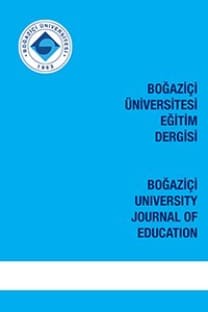Learning by Experiencing the Space: Informal Learning Environments in Architecture Education
Informal Education, Informal Learning, Higher Education, Architectural Education, Modes of Education
___
- Barab, S. A., & Kirshner, D. (2001). Rethinking methodology in the learning sciences. Journal of the Learning Sciences, 10(1/2), 5-15.
- Bayindir, D., (2010). Reasons for student trips to botanic gardens: a case from Turkey (Unpublished master’s thesis). Bogazici University, Istanbul.
- Bell, P., Lewenstein, B., Shouse , A, W., & Feder, M. A. (Eds.). (2009). Learning science in informal environments: People, places, pursuits. Washington, DC: The National Academies Press.
- Coombs, P. H., & Ahmed, M. (1974). Attacking rural poverty: How NFE can help. Baltimore: John Hopkins University Press.
- Crowleu, K. & Callanan, M. (1998). Describing and supporting collaborative scientific thinking in parent-child interactions. Journal of Museum Education, 23(1), 12- 23.
- Dierking, L. D. (1991). Learning theories and learning style: An overview. Journal of Museum Education, 23, 12-17.
- Erktin, E., & Soygeniş, S., (1998, December). Sekiz yıllık eğitimde, çok işlevli tek ve tek işlevli farklı eğitim mekanlarının birlikte kullanımı. İlköğretim Binalarının Tasarım Açısından Değerlendirilmesi Sempozyumu, Mimar Sinan Üniversitesi, İstanbul.
- Eshach, H. (2006). Bridging in-school and out-of-school learning: Formal, non-formal, and informal education. Journal of Science and Technology, 16(2), 171-190.
- Falk, J., & Balling, J. D. (1982). The field trip milieu: Learning and behavior as a function of contextual events. Journal of Educational Research, 76, 22-28.
- Falk J. H. (1983). Field trips: A look at environmental effects on learning. Journal of Biological Education, 17, 137-141.
- Falk, J. H. & Dierking, L. D. (1992). The museum experience. Washington, DC: Whaleback Books.
- Falk, J. H. & Dierking, L. D. (2000). Learning from museums: Visitor experiences and the making of meaning. Walnut Creek, CA: Altamira
- Falk, J. & Storksdieck, M. (2005). Using the contextual model of learning to understand visitor learning from a science center exhibition. Science Education,89(5,) 745- 778
- Gambrell, L. B. (1996). Creating cultures that foster motivation. The Reading Teacher, 50(1), 14-25
- Gerber, B. L., Marek, E. A., & Cavallo A. M. L. (2001). Development of an informal learning opportunities assay. International Journal of Science Education, 23(6), 569-583.
- Hidi, S. & Harackiewicz, J. M. (2000). Motivating the academically unmotivated: A critical issue for the 21st Century. Review of Educational Research, 70, 151- 179.
- Lave, J. (1988). Cognition in practice: Mind mathematics and culture in everyday life. New York: Cambridge University Press.
- Lucas K.B. (2000). One teacher’s agenda for a class to visit an interactive science center. Science Education, 84, 524-544.
- Maclelan, E. (2005). Conceptual learning: The priority for higher education, British Journal of Educational Studies, 53(2), 129-147
- Miles M. B. (1964). Innovation in Education. New York: Teachers College Press
- Ogbu, J. (1995). The influence of culture on learning and behavior. In J. Falk & L. Dierking (Eds.), Public institutions for personal learning (pp. 37- 51).Washington, DC: American Association of Museums.
- Peacock, A. & Bowker, R. (2004). Learning to teach ‘science’ out of school: Nonschool placements as part of a Primary PGCE Programme. Education + Training, 46(1), 24-32
- Pedretti, E. (2002). T. Kuhn meets T. Rex: Critical conversations and new directions in science centers and science museums. Studies in Science Education, 37: 1-42.
- Pumpian, I., Fisher, D, & Wachowiak, S. (2006). Challenging the classroom standard through museum based education. Matwah, NJ: Laurence Erlbaum Associates.
- Putman, M. & Walker, C. (2010). Motivating children to read and write: Using informal learning environments as contexts for literacy instruction. Journal of Research in Childhood Education, 24(2), 140–151.
- Ramsey-Gassert, L., Walberg, H. J., III, & Walberg H. J. (1994). Re-examining connections: Museums as science learning environments. Science Education, 78, 345-363.
- Rogers, A. (2005). Non-formal education: Practical schooling or participatory education. Boston, MA: Springer.
- Simkins, T. (1977). Non -formal education and development: Some critical issues. Manchester: Manchester University Press.
- Vadeboncoeur, J. A. (2006) Engaging young people: Learning in informal contexts. Review of Research in Education, 30, 239-278
- Vygotsky, L. (1978). Mind in society: The development of higher psychological processes. Cambridge, MA: Harvard University Press
- Wee, B. (2008). Moving towards sustainability? The face of environmental education in Singapore. Green Teacher, 83, 35-38.
- Werquin, P. (2010). Recognising non-formal and informal learning: Outcomes, policies and practices. OECD Publications.
- ISSN: 1300-9567
- Yayın Aralığı: 3
- Başlangıç: 1976
- Yayıncı: Boğaziçi Üniversitesi
Back to Basics: What Do Parents and Teachers Expect of Early Childhood Education and Care?
First Language Change in Turkish-English Bilinguals
Learning by Experiencing the Space: Informal Learning Environments in Architecture Education
Ebru BAĞ, Leyla MARTI, Yasemin BAYYURT
Psychological Counseling, Advocacy, Accountability and Technology
Uses of Narrative in English Language Studies: Cognition, Culture, and Narrative
